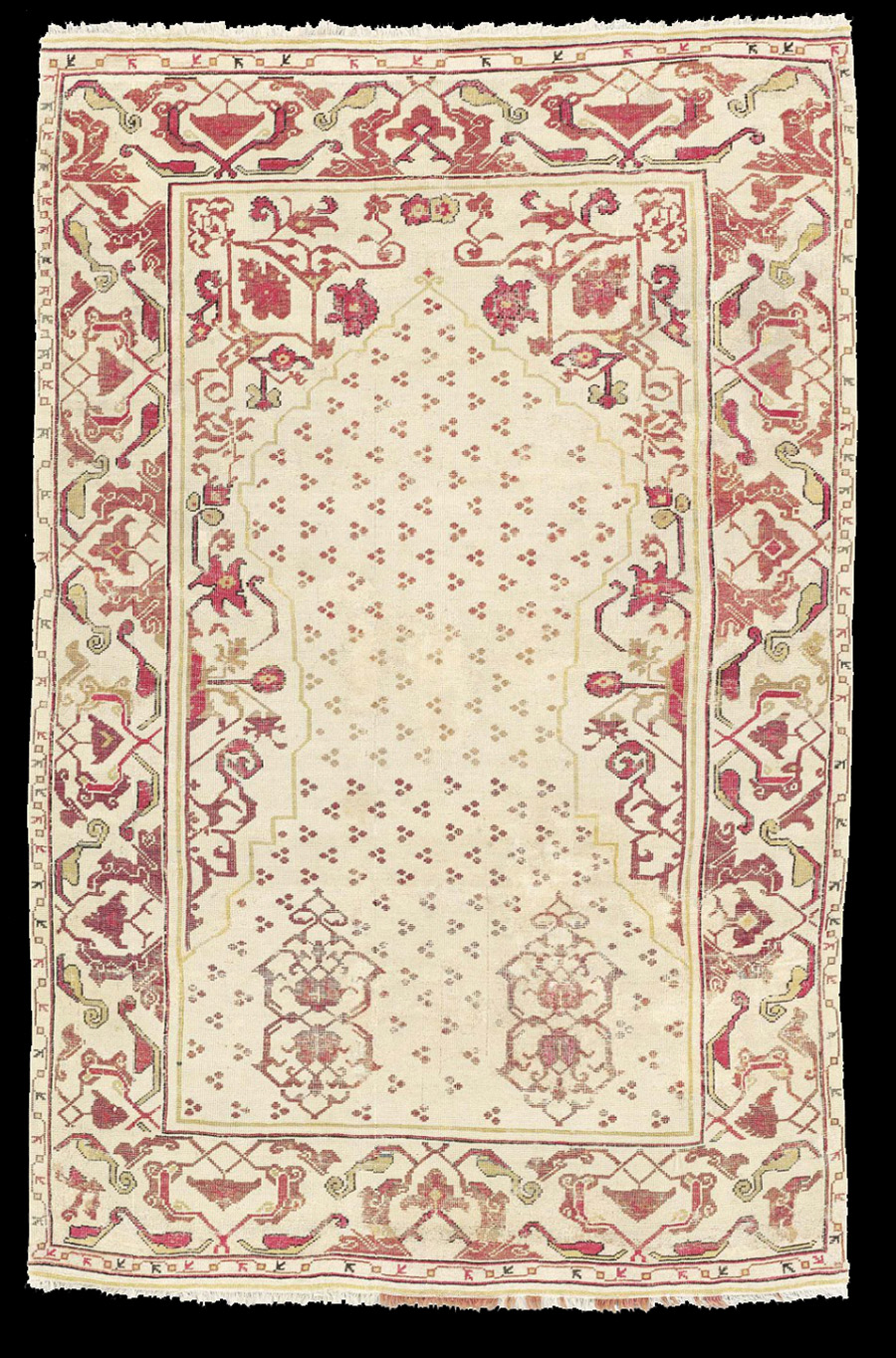A ÇINTAMANI PRAYER RUG
SELENDI OR USHAK, WEST ANATOLIA, LATE 16TH OR
EARLY 17TH CENTURY
Price Realized £73,875 ($112,659)
Estimate
£60,000 - £80,000 ($91,200 - $121,600)
Sale Information
Christies SALE 1116
ORIENTAL RUGS AND CARPETS
23 April 2013
London, King Street
Lot 50
A ÇINTAMANI PRAYER RUG
SELENDI OR
USHAK, WEST ANATOLIA, LATE 16TH OR EARLY 17TH CENTURY
Uneven overall
wear, scattered small cobbled repairs and associated repiling, a few
reweaves, sides partially rewoven, both ends rewoven along outer stripe
4ft.10in. x 3ft.2in. (147cm. x 97cm.)
Provenance
Paulette
Goddard Remarque
The Davide Halevim Collection, sold in these Rooms, 14
February 2001, lot 115
Pre-Lot Text
Property from a Private
Canadian Collector
Literature
Eberhart Herrmann, Asiatische
Teppich und Textilkunst, IV, Munich, 1992, no.12, pp.34-5.
Hali, Issue
108, Jan/Feb 2000, p.136
Lot Notes
This elegant and
spectacularly coloured cintamani prayer rug is a unique and particularly
beautiful example from this rare group of carpets. Marino Dall'Oglio notes
in his discussion of white ground Anatolian carpets that there are in
total about thirty white ground cintamani rugs and carpets of which about
twenty five are relatively small, similar in size to the present rug
(Marino Dall'Oglio, 'White Ground Anatolian Carpets', in Robert Pinner and
Walter Denny (ed.), Oriental Carpet and Textile Studies II, Carpets of the
Mediterranean Countries, London, 1986, p.190-191). Of these thirty
examples Dall'Oglio identifies two subcategories, the refined larger
carpets and the smaller simpler rugs. The present example refuses to fit
neatly into this classification as it has a finesse and sophistication
that sets it apart from the other small format cintamani prayer rugs such
as the Boehringer cintamani prayer rug sold in these Rooms, 24 April 2012,
lot 101 (for a discussion of this group see Jürg Rageth, 'A Selendi Rug:
An Addition to the Canon of White-Ground Cintamani Prayer Rugs', Hali,
Issue 98, May 1998, pp.84-91).
There are three published rugs that
relate closely to the present example, two of which are white ground
prayer rugs in the Museum of Turkish and Islamic Arts, Istanbul
(illustrated in Hali, Issue 25, January 1985, p.42 and Nazan Ölçer,
Turkish Carpets from the 13th to the 18th Centuries, exhibition catalogue,
Istanbul, 1996, p.201). Both of these rugs have a comparably shaped
mihrab, two waisted arabesque 'footprints' below and spandrels with
similar monochrome scrolling open arabesques but both have a divergent
border from the present example, a zig-zag Gothic border similar to the
border of a number of 16th century Bird Ushak carpets and is typical of
later 'kis' Ghiordes rugs. The third comparable rug is an abstracted or
'degenerate' cintamani prayer rug formerly in the Bernheimer collection,
published Otto Bernheimer, Alte Teppiche des 16.-18. Jahrhunderts der
Firma L. Bernheimer, Munich, 1959, pl.26.
Although the three rugs
are very similar to the present example, there is considerable difference
in the drawing. The present example is very close to the first of the
three mentioned above. The arabesques and floral motifs in the spandrels
are carefully drawn and balanced and the two 'footprints' in the lower
field are also very similarly delineated, whilst the second Turkish
example reduces them to a much stiffer version. The design of the
Bernheimer rug is likewise more angular and naive in its drawing than the
present example, but the similarities are undeniable. The rug appears to
bridge the divide between the two different groups of cintamani rugs,
fusing the sophisticated design of the present example with the more
archaic and tribal quality of the group of cintamani prayer rugs discussed
by Jürg Rageth, op cit.
The arabesque 'footprints' at the base of the
mihrab are very similar to those on a multiple prayer rug which was made
for the Selimye mosque in Edirne (Nazan Ölçer, op cit., p.174-5). The
shape of the outline of those examples leaves little doubt that they are
intended to be stylised feet, complete with pointed toes, in the same way
that Caucasian prayer rugs often have stylised hands. The panels at the
base of the present rug are slightly more stylised in shape but contain
very comparable arabesques. Rather than just being markers where to place
your feet, they are probably indications that you should pray in the
footsteps of the Prophet. They could also be indications of the sandals of
the Prophet, which were especially revered because the Prophet touched
them on the apex of the Divine Throne during his heavenly journey. An
interesting comparison can be made with a striking sixteenth century
Safavid Persian miniature from the Falnama where the main feature of the
composition is two feet filled with arabesques below an arch, completely
dominating the people praying below (Falk, Toby (ed.), Treasures of Islam,
exhibition catalogue, Geneva, 1985, no.63, p.97). |

